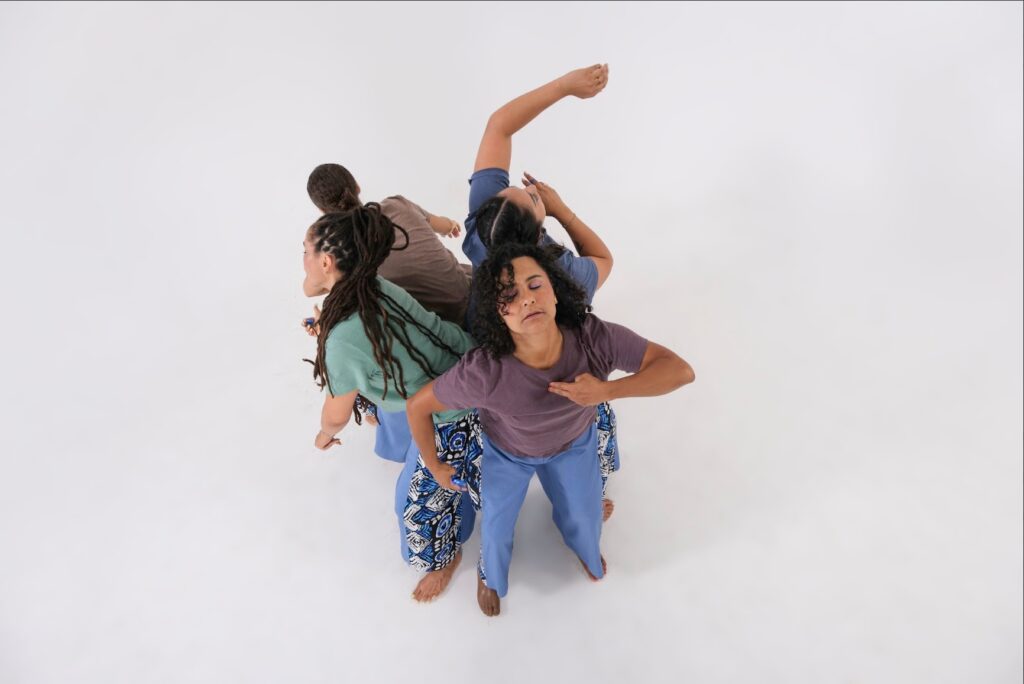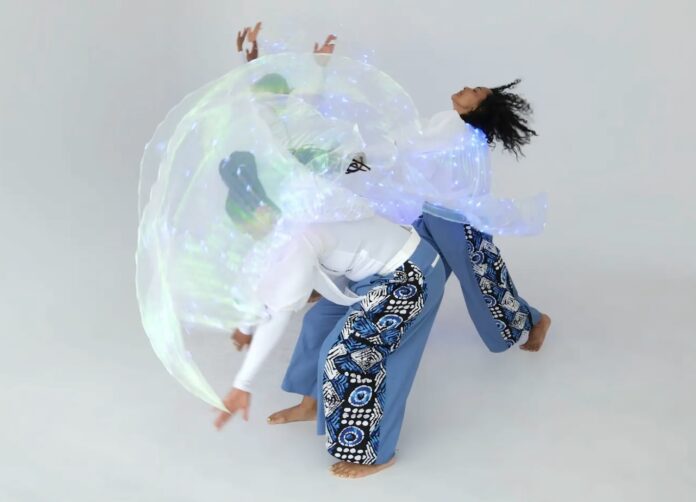There was a moment during this show when I sat in Dance Mission Theater and found myself thinking about, of all things, Taylor Mac’s A 24-Decade History of Popular Music. Mind you, I’ve never even seen that show, but its title popped into my head. One could easily argue that Adia Tamar Whitaker and Àṣẹ Dance Theater have created a two-hour-long speed-run through the history of Black music—from the villages Africa to the churches and streets of the US. In-between, the only thing that changed was the choice of clothing.
The aforementioned creative entities are the ones behind Following the Road to Ose Tura, which ran August 15–18). The project is described as “Whitaker’s dance and music response to The Road to Ose Tura,” a dance film created by the late Efeya Sampson, a choreographer and Ifá priestess. Officially referring to it as a “response” seems to connote that that show is some sort of challenge to Sampson’s work. In fact, it’s a pretty overt tribute to the late artist and beliefs from the Motherland (she’s credited as co-creator of Following…).
The show consists of multiple vignettes that were performed over three days at various outdoor locations around SF. Not being free to attend any of them, I had to imagine what site-specificity lent to the overall aesthetic, as many of the works seem designed to be performed in the dark. What’s more, one has to wonder how easy (or not) it would be to follow the subtle narrative about accepting mortality as a part of life. I caught the finale performance at Dance Mission, which combined all the work from the previous three days into one show. Yet, even I’d like to think I’d have been enlightened to a degree, even with a fraction of the experience.
As our troupe gathered in the initial blackout, lit only by blue finger-lights, one of the first things we heard was the plea “Will you help me die?” Initially shocking to western ears, but there was a point to be made here. This was the first of many movements that regarded death as something to embrace. Not in suicidal ideation, but in the sense that it’s the logical conclusion to birth, with which it goes hand-in-hand. Consider that Ifá is one of the many African religions that travelled with the slaves across the Atlantic. In South America and the Caribbean, those African beliefs had to be hidden behind the Catholicism forced upon the slaves, leading to hybrid faiths like Santería, and later influencing practices like Día de Muertos. As with the latter, death (in and of itself) is not something to fear.
This was combined with an Ifá story about a group of trees merging into one strong oak. (In fact, co-creator Whitaker wrote a Shayna Strype-animated short—which we watched—that uses this story as a parable for her own thyroidectomy.) Among all of this, we were transported from one spiritual world to another, the cacophony of Negro spirituals, drawing a direct evolutionary line between the dancing and singing in the villages to the Christian-influenced celebrations that have defined Black American gospel and worship as a unique entity unto itself.

We also saw dances of birth, dances of death, dances of weak patients in hospital gowns with “shoulder pads” made of pill bottles. There were projected films of prayer rituals in temples and on public streets. We witnessed joy in the most morbid of topics without falling into nihilism. All in a series of eye-popping costumes (for which there is, sadly, no designer credited).
Whitaker and Àṣẹ Dance’s tribute to Sampson and her faith was akin to one of the most joyful funerals one could ever attend. It’s probably no coincidence that this final, amalgamated performance took place on a Sunday, when so much of the show acts as an under-the-radar history lesson for all the “joyful noise” gospel that has become the Black Church’s trademark. Not being familiar with Sampson’s choreography, I can’t say where it stops and Whitaker’s begins, but perhaps the two are meant to be thought of as a fusion; akin to a child that is their own person, but unmistakably resembles their parents.
Of the dancing—modern and folk—it was energetic, fluid, and well-complemented by the vocals and live musical accompaniment (which included a banjo, the staple of white Southerners that’s finally having its African origins reclaimed). The vocals jump back-and-forth from melancholy pleas to celebratory wails. Even though the show (at two hours) goes longer than the 90min its creators planned, it makes for an immersive experience (complete with audience movement to different areas at one point) that’s best experienced in-person.
Another surprise was the contradictory nature of Dance Mission’s HVAC system. Very few of us were masked in the near-full theatre, and there was an inevitable stuffy feeling in the old building. Yet, the CO² readings on my Aranet4 never seemed to get any higher than 789ppm. In fact, they’d dropped down to 574ppm by the final bow. I would later check my Aranet4 to make sure it was working right (it was), because even the last Dance Mission show I saw earlier this year had levels around 1743ppm (which is still not the highest I’ve ever seen). How this show had such low levels with so many bare faces in a stuffy theatre, I can’t say.
What I can say is that one of this year’s better theatre experiences was watching this physical tribute to someone I’ve never met. The show connects centuries of African and Black American faith and dance into a glorious hybrid that bursts with life and color at every moment. Even though it went longer than expected, it was a shame that it had to end. Yet, the point of the entire show is that every ending is a welcome beginning to something new.





